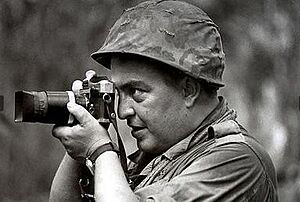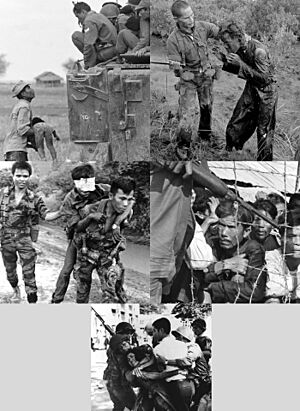Horst Faas facts for kids
Quick facts for kids
Horst Faas
|
|
|---|---|
 |
|
| Born | 28 April 1933 Berlin, Nazi Germany
|
| Died | 10 May 2012 (aged 79) |
| Known for | Photojournalism |
| Awards |
|
Horst Faas (born April 28, 1933 – died May 10, 2012) was a famous German photojournalist. He won the important Pulitzer Prize twice. He is best known for his powerful pictures from the Vietnam War.
Contents
Horst Faas's Life and Career
Horst Faas was born in Berlin, Germany, on April 28, 1933. At that time, Germany was known as Nazi Germany. As a young person, he was part of a group called the Hitler Youth.
Starting as a Photographer
Horst began his journey in photography in 1951. He worked for an agency called Keystone. By the time he was just 21 years old, he was already covering big news events. This included important peace talks in Geneva in 1954. These talks were about a region called Indochina.
Becoming a War Photographer
In 1956, Horst Faas joined the Associated Press (AP). This is a major news organization. He quickly became known as a brave war photographer. He covered conflicts in places like Vietnam, Laos, the Congo, and Algeria.
In 1962, he became the AP's main photographer for Southeast Asia. He was based in Saigon, Vietnam, until 1974. His amazing photos from the Vietnam War earned him his first Pulitzer Prize in 1965.
Injuries and More Awards
In 1967, Horst was badly hurt in his legs by a rocket-propelled grenade. Even after this, he continued his important work. In 1972, he won his second Pulitzer Prize. This award was for his coverage of the conflict in Bangladesh. Another photographer, Rashid Talukder, also took photos there. But he felt it was too dangerous to share his pictures until many years later.
Horst Faas was also very good at being a picture editor. He played a key role in making sure two of the most famous photos from the Vietnam War were seen by the world.
- In 1965, he took an iconic photo of a soldier. The soldier's helmet had "War Is Hell" written on it.
- In 1968, a photo called "Saigon Execution" was taken by Eddie Adams. This picture showed a Viet Cong prisoner being executed. Horst Faas was the one who made sure this powerful image was sent out to news outlets.
- He also made sure the famous "Napalm Girl" photo by Nick Ut was published.
In 1990, a freelance photographer named Greg Marinovich sent some very strong photos to the AP office. Editors were unsure if they should publish them. They sent them to Faas, who quickly replied, "send all photos." This shows his belief in showing the truth.
Later Years and Legacy
In 1976, Faas moved to London. He became the AP's senior photo editor for Europe. He retired in 2004. After retiring, he helped organize meetings for journalists who covered the war in Saigon. He also ran international events about photojournalism.
Horst Faas wrote four books about his career and other news photographers. One important book was Requiem. He co-edited it with fellow photojournalist Tim Page. This book was about photographers who died during the Vietnam War.
Awards and Recognition
Horst Faas received many important awards for his work:
- 1965: Pulitzer Prize for Photography. This was for his brave combat photography during the war in South Vietnam in 1964.
- 1964: Robert Capa Gold Medal. This award was for his excellent "Coverage of Vietnam."
- 1972: Pulitzer Prize for Spot News Photography. He shared this with Michel Laurent for their photo series called "Death in Dacca."
- 1997: Robert Capa Gold Medal. He shared this with Tim Page for their book Requiem: By the Photographers Who Died in Vietnam and Indochina.
- 2005: Dr. Erich Salomon Prize. This award from the German Society of Photography recognized his amazing work throughout his entire career.
See also
 In Spanish: Horst Faas para niños
In Spanish: Horst Faas para niños


